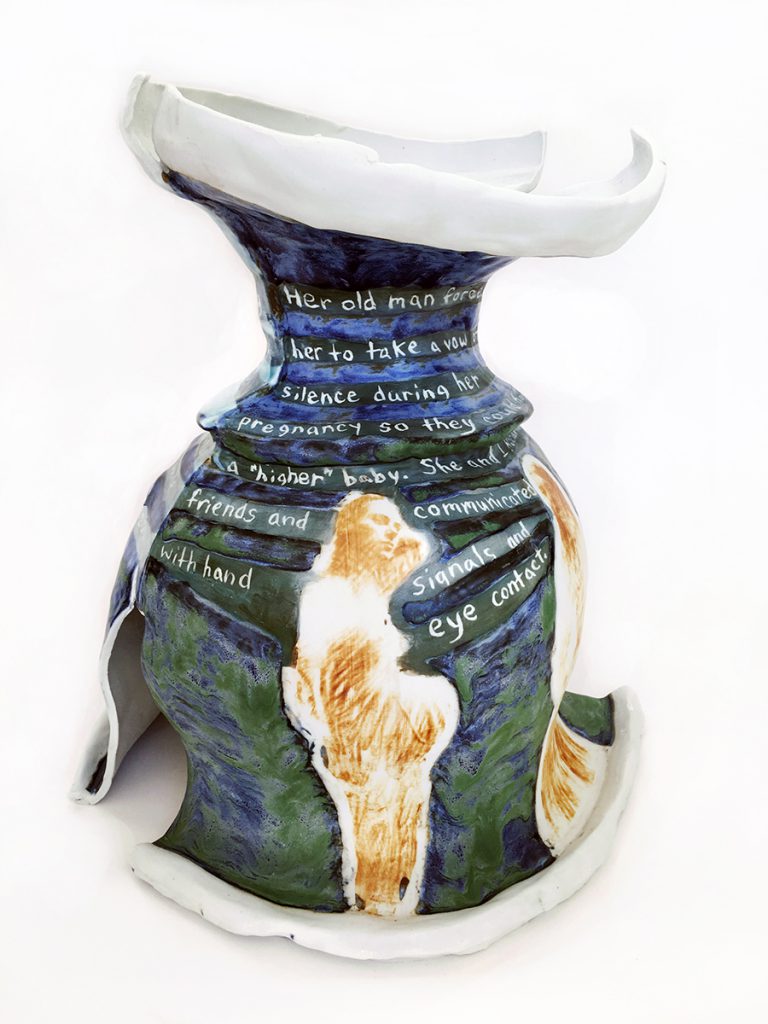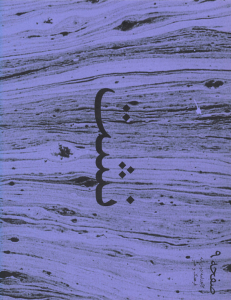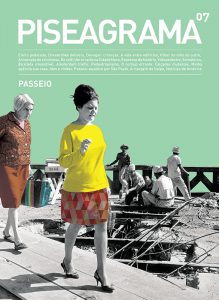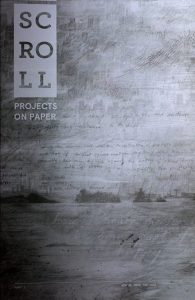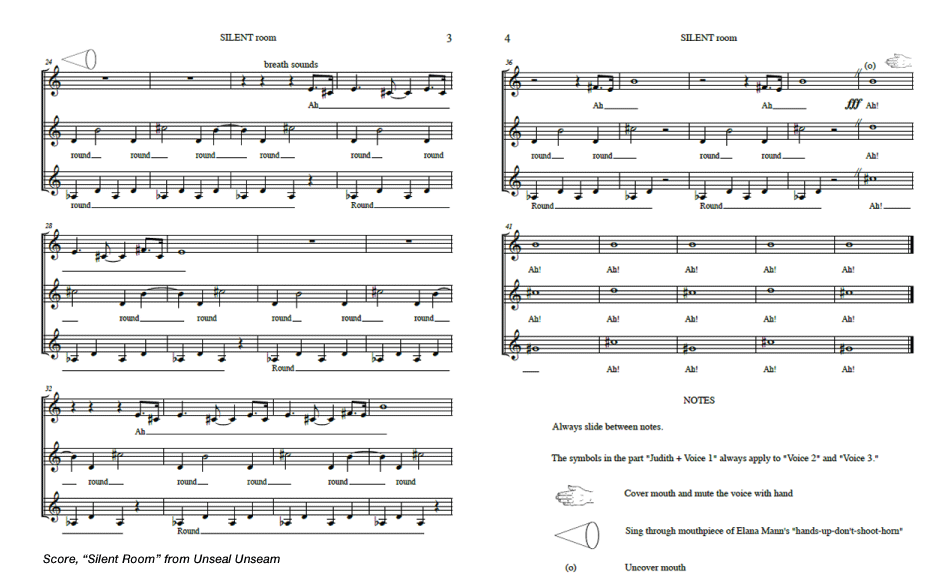May 2-18, 2019
Opening Reception: May 2, 5-7 p.m.
Nichols Gallery/Broad Center Patio
Elodie Arbogast, Allean “Mykale” Bankhead, Gina Duran, Hazel Hutchins, Jessica Jia 贾子芹, Olivia Kohn, Krystal Li 李祎然, Tess Regan, and Eve Wang 王楚怡
Elodie Arbogast
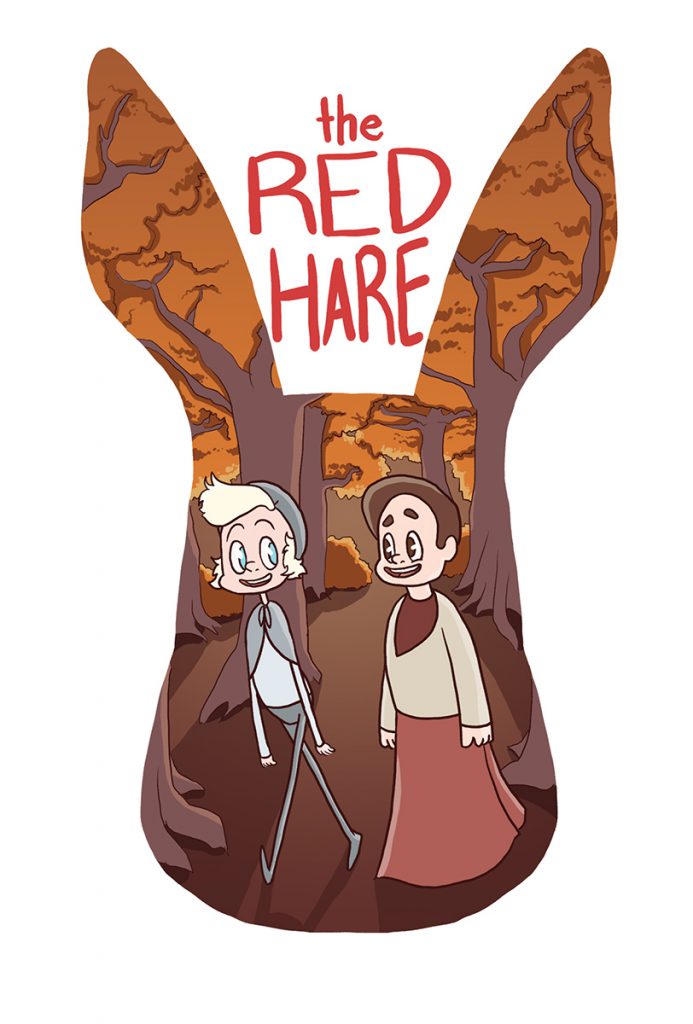
Elodie Arbogast is a double major in History and Studio Art and is a passionate consumer and creator of films, illustration and comics. Arbogast’s work consists of digital illustration, comics, graphic novels, short animations and storyboards.
Growing up, Arbogast had a much easier time understanding her feelings and problems through the lens of characters than she did handling them on her own. Whether it be from a TV show, book, folk tale, or especially an animated movie, seeing a character go through a similar struggle to her own was one of the only ways she could be honest with herself about her feelings. As she grew older, and relied less on using characters to understand herself, she began creating characters that would encourage others to experience a similar catharsis. Therefore, her primary focus is creating impactful characters, and using those characters as an avenue for communicating honestly about the world, in a way that can be cathartic and impactful for herself and the viewer.
“The Red Hare,” Arbogast’s thesis project, is a short graphic novel about two young sisters who chase a mythical red hare from their grandmother’s stories into the woods by their home. The story deals with childhood feelings of disappointment and irrationality. Specifically, it deals with the feeling of desperately wanting a particular thing, and then being disappointed by getting something different, despite it being objectively better. The characters try and cope with having thoughts and feelings that do not make sense, even to themselves, and must rely on the people closest to them to treat them with kindness and forgiveness. Arbogast incorporated her specialty in U.S. cultural history by including figures from folklore throughout the book, who challenge the sisters in various ways. Folkloric stories are often tonally light, absurd and humorous, yet they convey a wealth of cultural information through their depictions of fear, struggle, victory, etc. They take the light with the dark, an essential part of the human experience. Balancing seriousness and fun is essential in Arbogast’s works, from illustration to comics and films.
Allean “Mykale” Bankhead
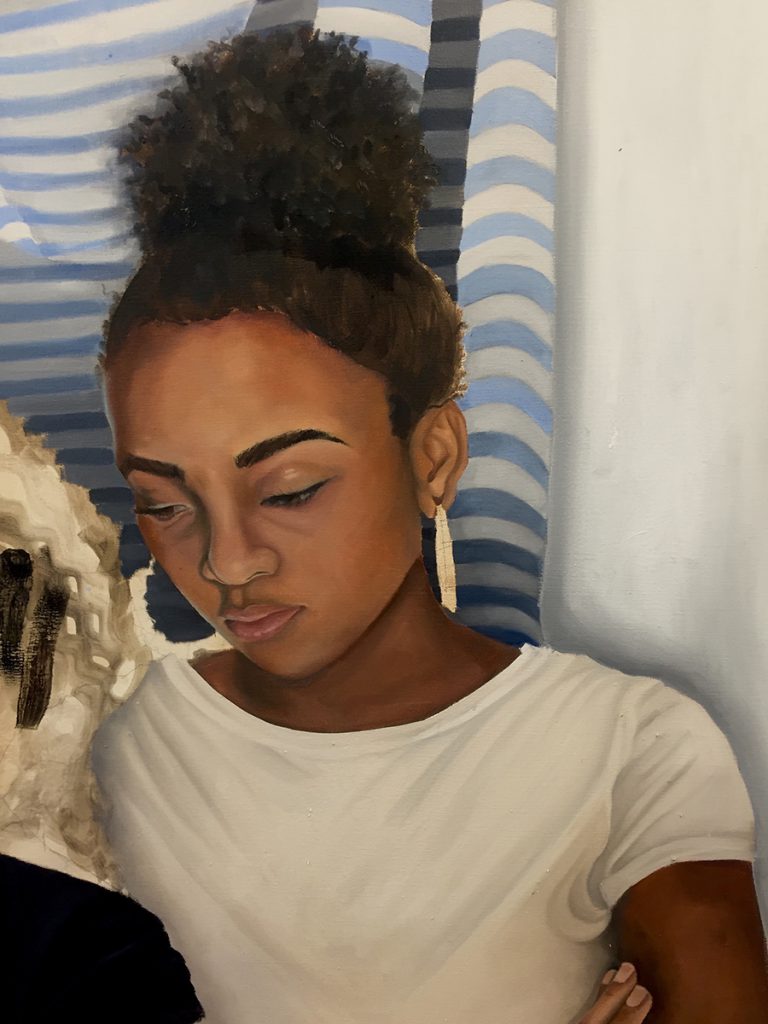
Initially trained in painting and drawing in the International Baccalaureate Program, followed by ceramics, welding, and woodworking at Pitzer College, Allean “Mykale” Bankhead incorporates multiple mediums to thematically explore the past. Whether the past of her own childhood artistic origins recreating cartoons and manga, the family traumas of her past, or the burden of experiencing racial prejudice in America; Bankhead uses her work as a way to better understand and process personal and social history. Manifest in ceramic plates with detailed floral paintings, t-shirts spray painted with intricate stencils, and even including traditional oil paintings of anime characters, her works primarily result in heterogenous forms that heavily incorporate and rely upon illustrative qualities.
In “Nothing Gold Can Stay,” Bankhead is exploring the intersection of the traditional (two-dimensional) art form of oil painting with more contemporary sculptural (three-dimensional) art form of plaster to cooperatively express and instill an emotional response in the audience. Incorporating the movement, time and multiple meanings of honey, these various mediums all come together to depict a large-scale family portrait. Whilst the figures in the painting are depicted in a fairly direct way that suggests a sense of melancholy or pensiveness, the sculptural aspects of the plaster and honey cooperatively offer inklings of loss and depletion. The emotional quality that these figures display propose questions regarding the truth and actual state of familial relationships. Furthermore this emotional quality addresses issues such as the societal pressures of maintaining familial relationships, regardless of the real state of these relationships.
Exploring this theme by depicting African Americans figures, Bankhead is inspired by contemporary artists who often work in portraiture such as Kara Walker, Kehinde Wiley, and Delfin Finley. Along with the thematic explorations of familial relationships, Bankhead also analyzes the intersection of not only African American familial relationships, but also the decades long and continuous effort to contextualize and establish black figures in art galleries and museums. With implications and complex intersections such as these Bankhead wishes to investigate and discuss bigger questions such as; to what extent are we expected to keep and maintain familial relationships?, what are we truly losing and gaining from keeping these relationship, and are the results worth it? and how does a black artist handle depicting black figures and more importantly black
narratives in a white gallery space?
Gina Duran
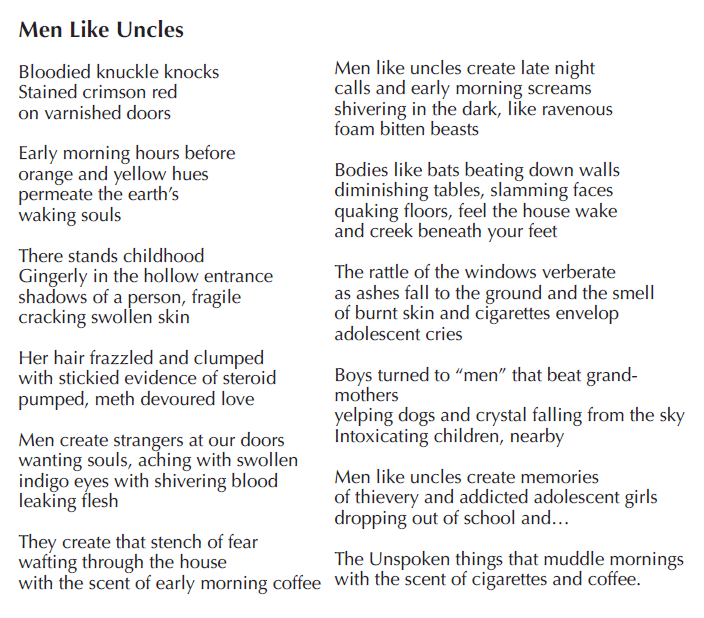 Gina Duran’s artwork takes a social and introspective view on the historical, emotional, and psychological issues of sexual violence––which her research at the University of Illinois, Urbana Champaign has brought her to describe as an assimilation response. Her work exemplifies the crucial topic of transitioning from victim to survivor by using her body as the main medium and subject of representation for the struggles of dissociation, self-harm, and suicidal ideations.
Gina Duran’s artwork takes a social and introspective view on the historical, emotional, and psychological issues of sexual violence––which her research at the University of Illinois, Urbana Champaign has brought her to describe as an assimilation response. Her work exemplifies the crucial topic of transitioning from victim to survivor by using her body as the main medium and subject of representation for the struggles of dissociation, self-harm, and suicidal ideations.
Influenced by Marina Abramović’s “Rhythm 0”, Duran uses her body in a bound performance to demonstrate the struggles of belonging as a queer Indigenous Chicanx, while standing on red-earth for a prolonged period of time–– symbolizing rising up and transformation in hopes of leaving behind the past. Duran will release herself from her binds, demonstrating her battle, and shed the rope on the red-earth platform (which will be used later to make bowls). The bowls will become gifts for people that helped Duran throughout the healing journey and act as a final goodbye to her uterus. The uterus is located in the second chakra and is where creation/ creativity comes from. Since Duran is a mother of two, she chose to demonstrate her removed dysfunctional vessel through functional vessels that hold nourishment. Duran uses installation to bring the audience into her anamnesis as she sheds her past to move into her future by utilizing mixed mediums, such as; poetry from her research, inspired by Gloria Anzaldua’s “Borderlands” and Andrea Smith’s “Conquest: Sexual Violence and American Indian Genocide”––which informs the porcelain and latex castings of her body––and the painted backdrop of her daydreams with sounds of the wind. The porcelain casting of her body is scarred with poetry about childhood trauma, then marked around the abdomen to display the significance of sexual violence and the loss of her uterus. The final shedding is a latex casting of her body––exploring existence in the present by showing the wounded skin––laid before its body’s dreams with the aurora borealis spray painted onto a backdrop.
Sexual violence attributes to the highest percentages of extreme assimilation responses, such as: suicide, self-harm, and addiction amongst intersectional populations within stigmatized communities like LGBTQ2 (Lesbian, Gay, Bisexual, Transgender, and Two-Spirit) individuals. After working with LGBTQ2 homeless youth, receiving training as a Community Health Worker, losing her cousin to suicide, and attempting suicide, in 2005––she became aware of the correlation between sexual violence and suicide. Gina’s research led her to find that Native American women had the highest rate of suicide, as well as experience the highest rate of sexual violence. LGBTQ individuals are the second highest victims of sexual violence and suicide. Although Latinx and Chicanx individuals do experience sexual violence, they are often ‘othered’ in ways which do not recognize them as a race, increasing the experience of cultural shame and silence. It was because of this silence that she worked with Queer Latinx female identified survivors to write auto-ethnographic research in the form of poetry, fiction, and creative non-fiction.
Hazel Hutchins
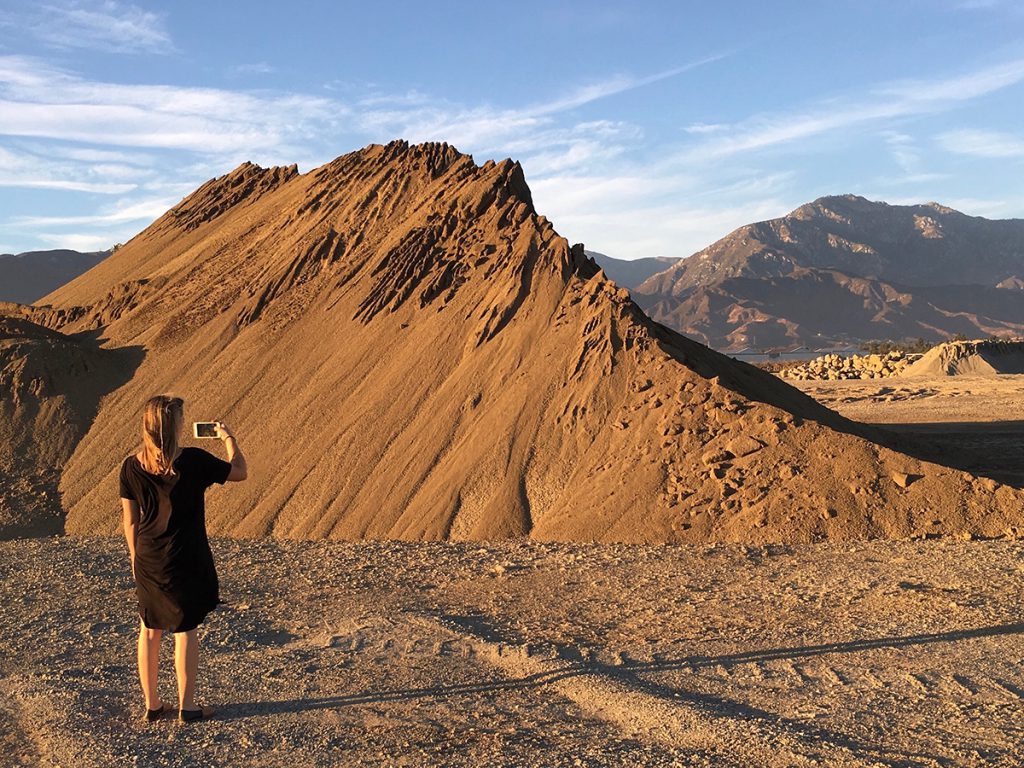
Hazel Hutchins is a visual artist raised in North Salem, NY and New York City. Having been raised in both a dense city and a greener suburban landscape, she maintains a dual perspective that informs her artistic practice of exploration, concern with natural/built environments and the communities that inhabit them. Hutchins primarily works in photography and with found objects and has expanded her practice during college to incorporate sculpture and performance.
Hutchins’ thesis is a culmination of her time spent interacting with a local site in Upland, CA. Located just off of Foothill Boulevard (Historic Route 66) the expansive site holds debris, wild plants, and three family-owned companies, Holliday Rock Inc., Hub Cap Annie & Wheel, and Cable Airport. Hutchins’ gallery installation features video of her improvisational performances and interactions with the land, as well as, assemblages and sculptures comprised of found objects she collected from the site.
Situated within the frameworks of the Land Art movement, Hutchins’ utilizes features of the landscape as an artistic medium and makes work as a point of access to reflect and mobilize around a multitude of environmental concerns. Hutchins acknowledges that her artwork takes place on Indigenous land and expresses gratitude toward the local Tongva Tribe for hosting her. Her objective is to develop a creative relationship with the land throughout the duration of her thesis project.
Jessica Jia 贾子芹
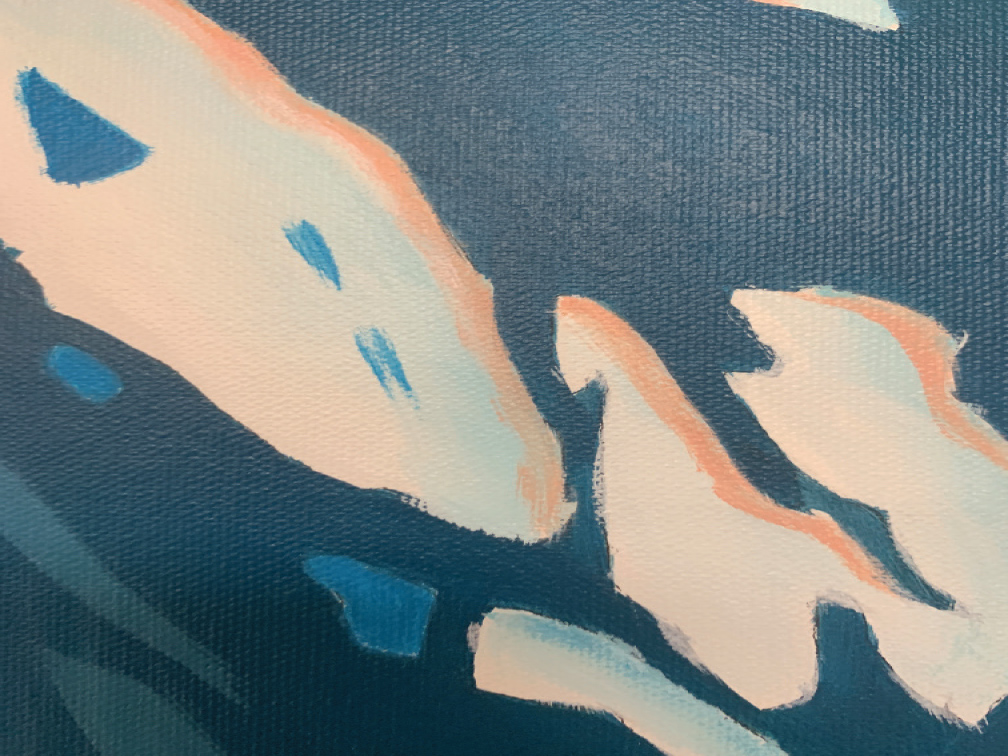
Ziqin “Jessica” Jia was born in China and moved to the United States when she was just 14 in order to attend school. She came to the United States alone and this forms the basis for the content for her artwork. She is very specific about what she uses to create her artwork and consistently employs similar materials and processes, although she is always open to exploring new ones. Jia typically uses oil paint, watercolor and/or pencil. She employs different methods to create small paintings versus larger paintings. For small paintings she likes to have a sketch then use tracing paper to transfer the image to another paper; whereas with large paintings she likes to draw a small sketch then use the projector to transfer the image onto the canvas or paper.
The title of Jia’s artwork for the 2019 Senior Thesis Exhibition is “The Blue Opium”. Her challenging experience growing up and studying away from her family has fostered her creative spirit and then became the basis of her artwork. In this artwork she wanted to express herself by showing the experiences she has been through and how they have affected her outlook on the larger world. As an international student from China, coming to the US was very lonely and this resulted in her being homesick. Jia has made a second home in the ocean, spending her free time deep sea diving. Diving has helped her to overcome these personal feelings of isolation and she wanted this to be the basis of her artwork. Being underwater is also a lonely place to put oneself because you cannot easily communicate with others and you are surrounding by large expanses of emptiness there. She was nervous the first time she dove but after a few times, she got used to the ocean and now is very comfortable with it. She liked how she dealt with her loneliness and in the process she learned how to be with herself.
Jia suffers from depression, which has led her to be anti-social. She struggles with being social and talking to and socializing with others is taxing for her. Being underwater is her comfort zone. She feels relaxed and released when she is diving. “The Blue Opium” gives an insight into her world by referring to the ocean as a sanctuary. In order to create this artwork Jia collaged photos that she took along with photos her friends took of her to make an image that combined different facets of her experiences. All of the photos were taken in Palau. She then used a projector to transfer the collaged image onto the 42’’ x 45’’ canvas. She was inspired by the artists Jessica McCoy and Allison Brown. McCoy and Brown are both known for their paintings and public art projects. McCoy’s work is also based on collaged photos which she paints with watercolor. Brown has done many mural paintings where she uses a dry brush technique to blend colors.
Olivia Kohn
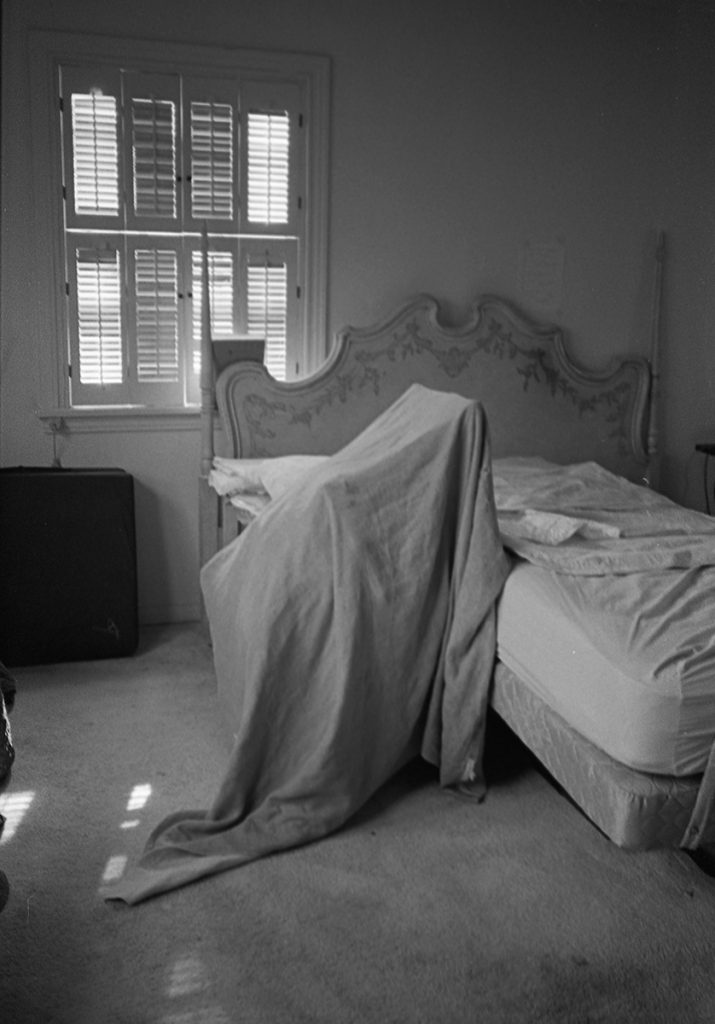
Olivia Kohn grew up in Los Angeles and has been largely influenced by her father’s work in the art world and her early exposure to contemporary art. Primarily working with analog photography, darkroom practice
continues to be her main vehicle for production, using both alternative and historical methods of darkroom printing. She uses the camera as a means of understanding her environment and documenting her domestic spaces.
In Poppy, a series of images capturing her grandparent’s home, Kohn uses black and white analogue photography to encapsulate how her grandfather’s dementia has affected the space he inhabits. She is investigating the presence of objects which represent time, and the conversation between familial subject and object. Marianne Hirsch speaks to this notion in her book Family Frames; “The familial look, then, is not the look of a subject looking at an object, but a mutual look of a subject looking at an object who is a subject looking (back) at an object.” Documenting objects which represent her grandfather’s illness juxtaposed next to objects in the house which represent the past, Kohn’s photographs switch between her grandfather’s gaze and her own. These gazes meet in her photographs, through displaying photographs which are representative of how she believes he sees the house, while others display the disarray and state the house is in, the house that Kohn sees. Kohn uncovers memories within the home and captures the absence and discomfort that has become of the space.
The psychology of the body and trauma is a running theme throughout her work, drawing from forms of surrealism and feminist portraiture to create a series that speaks to how one is able to process emotion and memory. Kohn is looking at the ways in which the house or home and the body are inherently linked, as her grandfather’s house deteriorates parallel to her grandfather. Repetitive images that appear throughout her body
of work allude to her fascination with process and the unconscious. In looking at artists who utilize family snapshots as markers of memory and familial history, such as Lorie Novak and Sophie Calle, her work speaks to
similar themes while also expanding this concept to the family home as descriptive of family life.
Krystal Li 李祎然

Krystal Li is a conceptual artist. Using multi-media such as video, sound and photography Li explores topics such as autobiography, identity and longing. As an international student from China, her culture, memories and present life in the United States have inspired her to make art.
Captured from Li’s everyday life and surroundings, the sound installation The Untitled is inspired by Li’s interest in “everyday aesthetics”. “Everyday aesthetics” is a contemporary philosophical position that focusing on everyday life, the environment, people and daily activities. The Untitled contains multiple different sounds from Li’s daily routine including at school and her social life with friends. To Li, these sounds are the most frequent and familiar sounds surrounding her, yet something that normally goes by unappreciated. Li intentionally designed a private dark room in the gallery for viewers to have their own private space and time to process her work. This is particularly important because the privacy of the space allows the listener to process her work without distraction and relate the sounds to their own everyday experience. By utilizing sound, Li aims at surrounding her viewers through this particular medium and encouraging an open interpretation of the work.
A minimal aesthetic approach is essential to Li’s work. She has been influenced by artists such as Marcel Duchamp, Ai Weiwei and Ugo Rondinone. Li reduces the work to only that which is essential in order that the central message she wants to convey to viewers is foremost. This encourages the listener to blend into the environment and process the artistic message.
Tess Regan
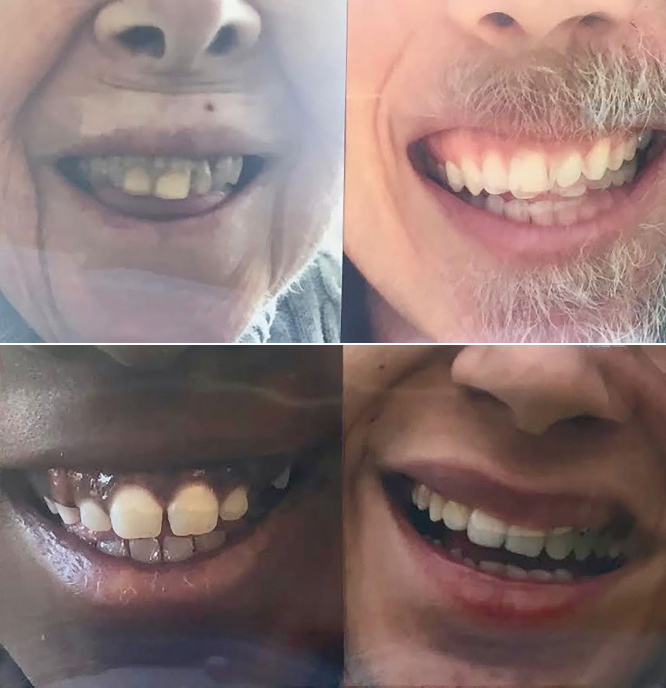
Born and raised in the Northeast, with a detour of a few years living abroad, Tess Regan’s outdoorsy and adventurous upbringing is reflected in her artwork which focuses on both the natural world and human connection. For her senior thesis project, “Smilehood,” Regan wanted to create an upbeat project that would highlight a natural, instinctual response of glee or giddiness from the audience within the gallery space. So, she began researching smiles and laughter. What began as an intended project of happiness and joy progressed into a more complicated anthropological study of human sociability.
Through her research, Regan drew on information from Robert Provine Paul Ekman and Anca Parvulescu as well as inspiration from Bas Jan Ader’s I’m Too Sad to Tell You and Barbara Krugers’ Have Me Feed Me Love Me Need Me. Her findings suggest that the story of smiles is an ever-evolving one, overlapping with drastic shifts in Western culture. For instance, smiling’s emergence in photography at the end of the nineteenth century overlapped, by no coincidence with the advancement of the advertising industry promoting signature smiles and social capital as toothy happiness. However, based on the findings of Provine and Eckman, smiling is not unique to happiness, but rather a response to social interactions. Therefore, Regan wanted to create an honest art project that would portray a wider array of emotions within the smile. This turn of the century also shifted women’s relation with smiling. Smiling which was once discouraged “lest it produce precocious wrinkles” transformed into encouragement to smile more for the sake of acquiescent femininity.
For her project, “Smilehood,” in About Time, Pitzer’s senior thesis exhibition, Regan presents a series of lenticular prints, images with an illusion of depth and the ability to shift between distinct images, depending on the viewing angle. The series consists of four lenticular prints, each composed from two different photographs of smiles. The eight images were selected from an extensive archive of smile photographs taken over months. Out of context, a collection of smiles may appear macabre; however, contextualization of the intent to represent social, human connection will hopefully elevate the response to one of blithe recognition. Through
her research she has focused on the social reasons for smiling and laughing and the situational contexts in which they are found. In short, the anthropological research has boiled down to smiles existing as an instinctual response to social cues, not exclusive to happiness, but universal to human behavior.
Eve Wang 王楚怡
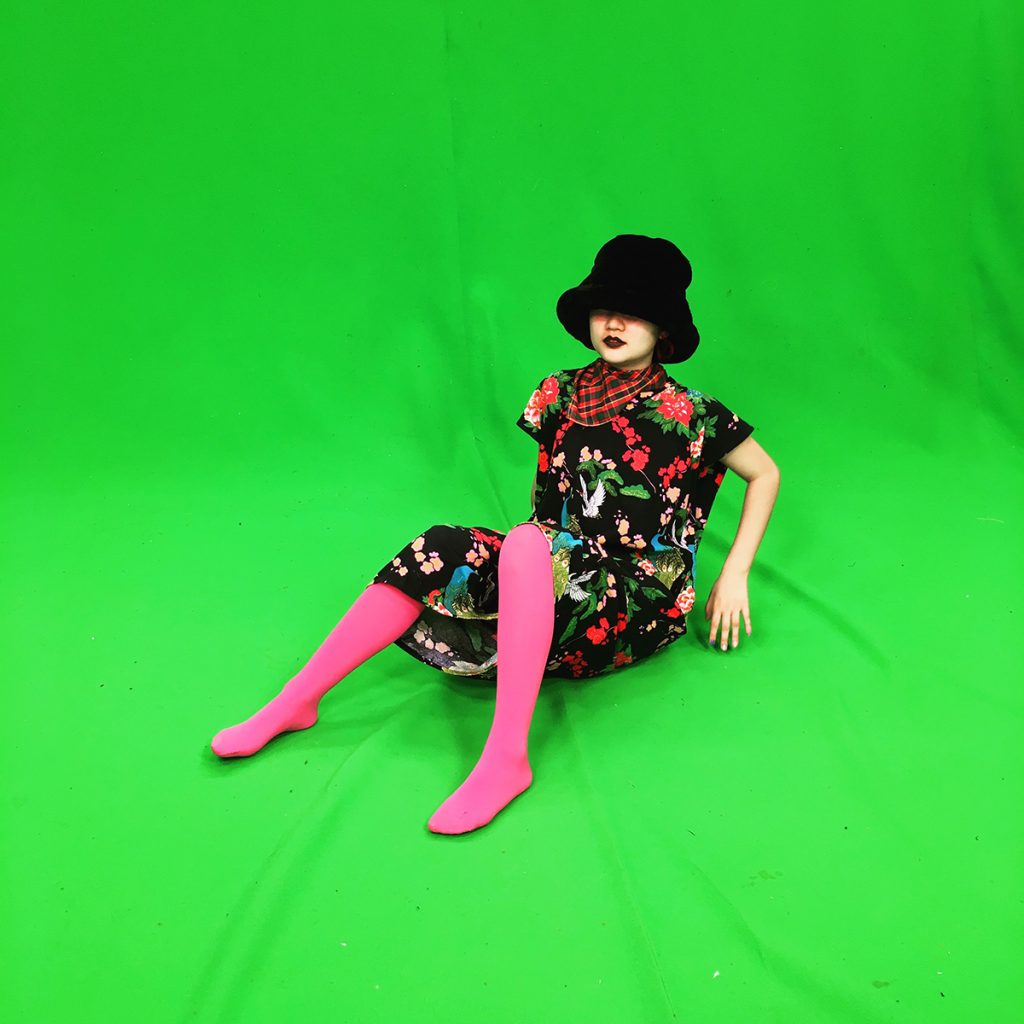
Eve Wang is a visual artist and a performer. She grew up in Beijing, China and moved to the United State four years ago for college. Being away from home, she has spent a great deal of time contemplating the theme of “home”. She believes in the idea of an artist’s emblematic role as DJ (Baudrillard). Influenced by her experience of moving between two places, she “samples” elements from her past in China and her present in Claremont creating images and videos that manifest a third space. Her work is a bricolage drawn from her past experience, historical references, memory, and even mass-produced goods from China such as the electronic products one finds in the market of Huaqiangbei. Removing all of these objects from their original context, she questions how the body navigates a post-modern, post-colonial condition through technology.
Wang’s thesis is an installation and video. She uses sculpture because the physicality of things is the most striking in a three-dimensional gallery space. Her installation is made up of objects from local thrift stores and online shops. The installation itself is a flower garden of (fake) plants and water pond without water. Water plays a central role as the creator of life in many cultures. In Chinese mythology, the deceased passes through the lethe river to be reincarnated. In this piece each object also has its own organic life, by going through the different production and consumption methods. They reflect what is happening around us. By employing these objects, she hopes to raise the questions about identity and collective history. China is always mythically portrayed as threatening to overrule western domination of technological development, and at the same time “made in China” is stereotyped as cheap and tacky. By putting them in an enigmatic and cohesive form, she suggests an imagery that does not exist in the present yet. Taking advantage of the pond’s double meaning, the whole art piece is a contested ground for the idea of a new, more robust form of life to which the digital explosion of technology is giving way. The project title, Freeze me when I die, reflects the contemplation on human life in the age of rapid technological development and the meaning of death in the age of cryogenic preservation, and asks the question of how ancient myths such as Buddhist reincarnation will manifest themselves.
Wang’s project is informed by theories developed in texts such as Hal Foster’s The Archival Impulse and Nicholas Baudrillard’s Post-production. Artists such as British painter Vivienne Zhang with her juxtaposed use of the internet glitch and the African rug, and Mika Rottenberg’s sculptural and video installation work, which reflect her contemplation of human labor also inspired Wang’s work.
 WORLD IS WATCHING – MANIFESTO
WORLD IS WATCHING – MANIFESTO